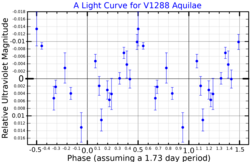21 Aquilae is a solitary[14] variable star in the equatorial constellation of Aquila. It has the variable star designation V1288 Aql; 21 Aquilae is its Flamsteed designation. This object is visible to the naked eye as a dim, blue-white hued star with a baseline apparent visual magnitude of about 5.1. The star is located at a distance of around 680 light-years (210 parsecs) from Earth, give or take a 20 light-year margin of error. It is moving closer to the Earth with a heliocentric radial velocity of –5 km/s.[6]
| Observation data Epoch J2000 Equinox J2000 | |
|---|---|
| Constellation | Aquila |
| Right ascension | 19h 13m 42.70120s[2] |
| Declination | +02° 17′ 37.3103″[2] |
| Apparent magnitude (V) | 5.06 - 5.16[3] |
| Characteristics | |
| Spectral type | B8II-III(Hg?)[4] |
| U−B color index | −0.399[5] |
| B−V color index | −0.065[5] |
| Variable type | α2 CVn[3] |
| Astrometry | |
| Radial velocity (Rv) | −5.2[6] km/s |
| Proper motion (μ) | RA: +10.102[2] mas/yr Dec.: −0.825[2] mas/yr |
| Parallax (π) | 4.7730 ± 0.1052 mas[2] |
| Distance | 680 ± 20 ly (210 ± 5 pc) |
| Absolute magnitude (MV) | −2.12[7] |
| Details | |
| Mass | 6.7[8] M☉ |
| Radius | 6.2[9] R☉ |
| Luminosity | 704[8] L☉ |
| Surface gravity (log g) | 3.95[8] cgs |
| Temperature | 12,014[8] K |
| Metallicity [Fe/H] | −0.20[10] dex |
| Rotation | 9.3 d[11] |
| Rotational velocity (v sin i) | 17[10] km/s |
| Age | 165[12] Myr |
| Other designations | |
| Database references | |
| SIMBAD | data |
The stellar classification of this star is B8 II-III, with the luminosity class of II-III suggesting that the spectrum displays elements of both a giant star and a bright giant. It is a chemically peculiar star of the Mercury-Manganese type (CP3),[10] although some catalogues consider that status to be doubtful.[15] This is a probable Alpha2 Canum Venaticorum variable that ranges in visual magnitude from 5.06 down to 5.16.[3] The star is radiating 704 times the luminosity of the Sun from its photosphere at an effective temperature of 12,014 K; this gives it the blue-white glow of a B-type star.[16]
21 Aquilae is catalogued as an optical double star, having a 12th magnitude companion 37″ away as of 2010. It was first identified as a double star by John Herschel.[17] The companion is a distant background object.[18]
References edit
- ^ Veto, B. (May 1980). "Ultraviolet Observations of the Silicon Star HD 179761". Information Bulletin on Variable Stars. 1778 (1): 1. Bibcode:1980IBVS.1778....1V.
- ^ a b c d e Vallenari, A.; et al. (Gaia collaboration) (2023). "Gaia Data Release 3. Summary of the content and survey properties". Astronomy and Astrophysics. 674: A1. arXiv:2208.00211. Bibcode:2023A&A...674A...1G. doi:10.1051/0004-6361/202243940. S2CID 244398875. Gaia DR3 record for this source at VizieR.
- ^ a b c Samus, N. N.; et al. (2017). "General Catalogue of Variable Stars". Astronomy Reports. 5.1. 61 (1): 80–88. Bibcode:2017ARep...61...80S. doi:10.1134/S1063772917010085. S2CID 125853869.
- ^ Cowley, A. (November 1972). "Spectral classification of the bright B8 stars". Astronomical Journal. 77: 750–755. Bibcode:1972AJ.....77..750C. doi:10.1086/111348.
- ^ a b Stepien, K. (December 1968). "Photometric behavior of magnetic stars". Astrophysical Journal. 154: 945. Bibcode:1968ApJ...154..945S. doi:10.1086/149815.
- ^ a b Evans, D. S. (June 20–24, 1966). "The Revision of the General Catalogue of Radial Velocities". In Batten, Alan Henry; Heard, John Frederick (eds.). Proceedings from IAU Symposium no. 30. Determination of Radial Velocities and Their Applications. Vol. 30. University of Toronto: International Astronomical Union. p. 57. Bibcode:1967IAUS...30...57E.
- ^ Anderson, E.; Francis, Ch. (2012). "XHIP: An extended hipparcos compilation". Astronomy Letters. 38 (5): 331. arXiv:1108.4971. Bibcode:2012AstL...38..331A. doi:10.1134/S1063773712050015. S2CID 119257644.
- ^ a b c d Fouesneau, M.; Andrae, R.; Dharmawardena, T.; Rybizki, J.; Bailer-Jones, C. A. L.; Demleitner, M. (2022). "Astrophysical parameters from Gaia DR2, 2MASS, and AllWISE". Astronomy and Astrophysics. 662: A125. arXiv:2201.03252. Bibcode:2022A&A...662A.125F. doi:10.1051/0004-6361/202141828. S2CID 245837778.
- ^ Kervella, Pierre; Arenou, Frédéric; Thévenin, Frédéric (20 December 2021). "Stellar and substellar companions from Gaia EDR3". Astronomy & Astrophysics. 657: A7. arXiv:2109.10912. Bibcode:2022A&A...657A...7K. doi:10.1051/0004-6361/202142146. eISSN 1432-0746. ISSN 0004-6361.
- ^ a b c Ghazaryan, S.; et al. (November 2018). "New catalogue of chemically peculiar stars, and statistical analysis". Monthly Notices of the Royal Astronomical Society. 480 (3): 2953–2962. arXiv:1807.06902. Bibcode:2018MNRAS.480.2953G. doi:10.1093/mnras/sty1912. S2CID 119062018.
- ^ Oelkers, Ryan J.; Rodriguez, Joseph E.; Stassun, Keivan G.; Pepper, Joshua; Somers, Garrett; Kafka, Stella; Stevens, Daniel J.; Beatty, Thomas G.; Siverd, Robert J.; Lund, Michael B.; Kuhn, Rudolf B.; James, David; Gaudi, B. Scott (2018). "Variability Properties of Four Million Sources in the TESS Input Catalog Observed with the Kilodegree Extremely Little Telescope Survey". The Astronomical Journal. 155 (1): 39. arXiv:1711.03608. Bibcode:2018AJ....155...39O. doi:10.3847/1538-3881/aa9bf4. S2CID 119515775.
- ^ Gontcharov, G. A. (December 2012). "Dependence of kinematics on the age of stars in the solar neighborhood". Astronomy Letters. 38 (12): 771–782. arXiv:1606.08814. Bibcode:2012AstL...38..771G. doi:10.1134/S1063773712120031. ISSN 0320-0108. S2CID 118345778.
- ^ "21 Aql". SIMBAD. Centre de données astronomiques de Strasbourg. Retrieved 2019-06-05.
- ^ Eggleton, P. P.; Tokovinin, A. A. (2008). "A catalogue of multiplicity among bright stellar systems". Monthly Notices of the Royal Astronomical Society. 389 (2): 869. arXiv:0806.2878. Bibcode:2008MNRAS.389..869E. doi:10.1111/j.1365-2966.2008.13596.x. S2CID 14878976.
- ^ Renson, P.; Manfroid, J. (May 2009). "Catalogue of Ap, HgMn and Am stars". Astronomy and Astrophysics. 498 (3): 961–966. Bibcode:2009A&A...498..961R. doi:10.1051/0004-6361/200810788.
- ^ "The Colour of Stars". Australia Telescope, Outreach and Education. Commonwealth Scientific and Industrial Research Organisation. December 21, 2004. Archived from the original on March 18, 2012. Retrieved 2012-01-16.
- ^ Mason, B. D.; et al. (2014). "The Washington Visual Double Star Catalog". The Astronomical Journal. 122 (6): 3466–3471. Bibcode:2001AJ....122.3466M. doi:10.1086/323920. Retrieved 2015-07-22.
- ^ Vallenari, A.; et al. (Gaia collaboration) (2023). "Gaia Data Release 3. Summary of the content and survey properties". Astronomy and Astrophysics. 674: A1. arXiv:2208.00211. Bibcode:2023A&A...674A...1G. doi:10.1051/0004-6361/202243940. S2CID 244398875. Gaia DR3 record for this source at VizieR.
